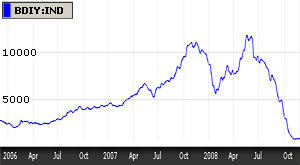LETTERS OF CREDIT….A reader at TPM provides three reasons why allowing Lehman Brothers to collapse was a bad idea, including this one:
Third, global trade is (still) largely conducted via letter of credit. With the possibility of well-known names disappearing, that system has broken down catastrophically. (Pull up the Dry Goods Shipping Index for confirmation.)
Right. I’ve read about this problem before, so I pulled up the Baltic Dry Index to see what he was talking about. This is a measure of the cost of shipping raw goods (iron ore, grain, coal, etc.), and sure enough, it’s cratered: from a peak of nearly 12,000 in May, it’s plummeted to a value of 824 this week.
But what’s the cause? Partly it was the commodity bubble earlier this year, which was unsustainable. Partly it might be weak demand from China. And partly it’s just a reflection of the recession we’re entering. It’s not easy to mothball ships, so even a small downturn in shipping demand can have an outsized effect on shipping prices. But what about those letters of credit? Are problems with the LoC market shutting down the shipping industry even beyond normal recessionary levels? Here’s John Dizard’s take in the Financial Times from a couple of weeks ago:
While the BDI has been dropping for months, the real collapse took place from the week after the Lehman bankruptcy….I had followed shipping in past years, but had never seen a rate of change like that. So I called friends of mine in that world to get closer to the car wreck. I had wondered if the BDI was truly representative of real-world values, or if it was oversold in the way some credit default swap indices might be. Nope. Ships really are that cheap. As one broker told me: “I just chartered a Handymax to go to the US Gulf from India for $1,000 a day. So the BDI really is pretty accurate.”
A Handymax vessel would typically displace about 40,000 deadweight tonnes. You would notice it if it dropped anchor near your dock. The cash operating costs are at least $1,500 to $2,000 a day. On top of that, figure another couple of thousand dollars a day for the capital costs….Those low charter rates indicate that not much is being shipped, apart from cargoes going from one corporate subsidiary to another, or from one highly creditworthy entity to another. It all goes back to that Lehman bankruptcy. Among the more serious casualties of that colossal failure of leadership was the letter of credit business.
There is nothing more vanilla than the l/c for an international shipment. One bank tells another bank that it will accept the credit risk of an individual importer or exporter. They document that, with forms that have been around forever, clerks and computers shuffle the paper around. A fee is charged and goods are released for shipping, inspection, and delivery. The most boring business in the world. Until it stops.
So here’s a question I can’t find an answer to with my meager Google skills: Is there some direct measure of the availability of letters of credit? Problems in the shipping industry suggest that LoCs are in trouble, but is there some index that actually tracks the total volume of LoCs over time? Is it really true that no one wants to accept anyone else’s LoCs anymore, or is this more rumor than fact? Anybody know of any pointers to hard evidence on this score?
POSTSCRIPT: As long as we’re at it, how about some measure of total global shipping? Is this a gigantic black hole, the way it is for the oil segment of the shipping market, or do we actually have any decent hard data for the total volume of shipping worldwide?



















